Oldsmobile Achieva 1997 s Owners Manual
Manufacturer: OLDSMOBILE, Model Year: 1997, Model line: Achieva, Model: Oldsmobile Achieva 1997Pages: 372, PDF Size: 18.52 MB
Page 91 of 372
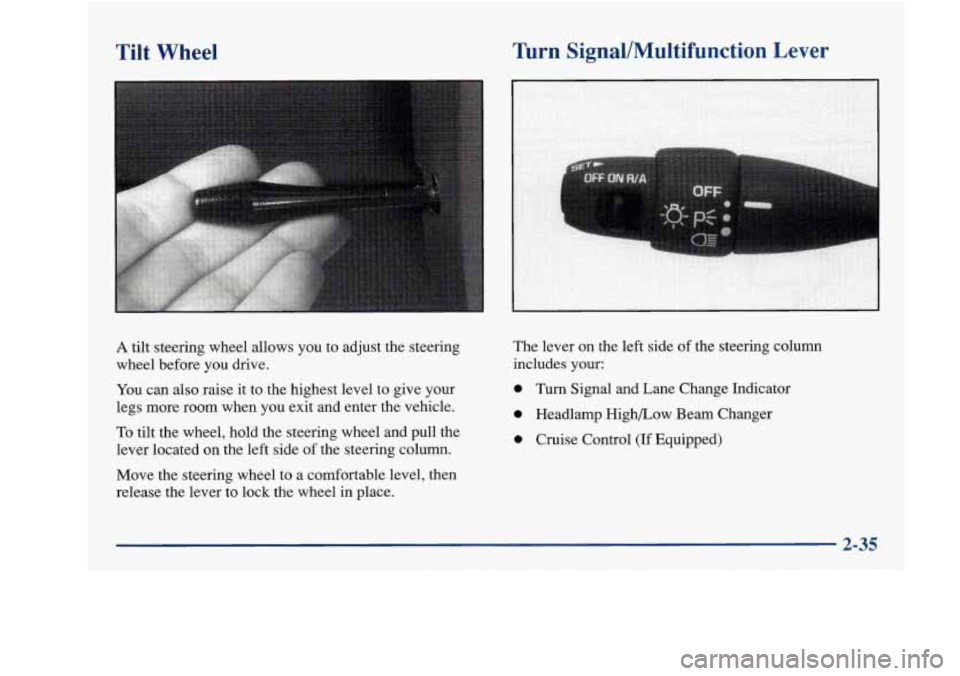
Tilt Wheel Turn
Signal/Multifunction Lever
A tilt steering wheel allows you to adjust the steering
wheel before you drive.
You can also raise it to the highest level to give your
legs more room when you exit and enter the vehicle.
To tilt the wheel, hold the steering wheel and pull the
lever located on the left side of the steering column.
Move the steering wheel to a comfortable level, then
release the lever to lock the wheel
in place. The lever
on the left side of the steering column
includes your:
0 Turn Signal and Lane Change Indicator
0 Headlamp High/Low Beam Changer
0 Cruise Control (If Equipped)
2-35
Page 92 of 372
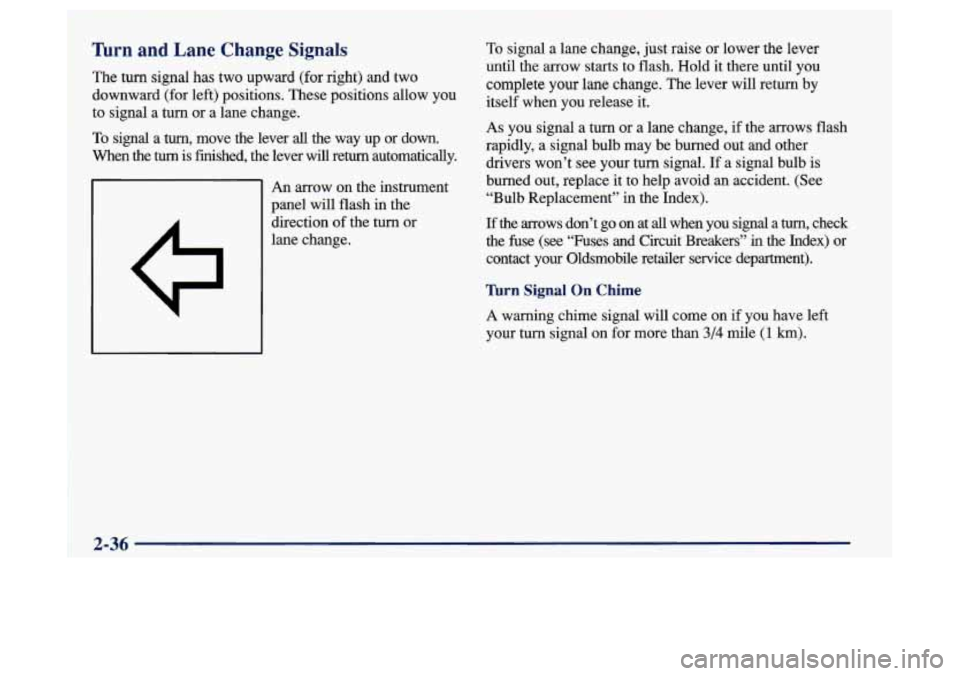
Turn and Lane Change Signals
The turn signal has two upward (for right) and two
downward (for left) positions. These positions
allow you
to signal a turn or a lane change.
To signal a turn, move the lever all the way up or down.
When the
turn is finished, the lever will return automatically.
An arrow on the instrument
panel will flash in the
direction of the
turn or
To signal a lane change, just raise or lower the lever
until the arrow starts to flash. Hold
it there until you
complete your lane change. The lever will return by
itself when you release it.
As you signal a turn or a lane change,
if the arrows flash
rapidly, a signal bulb may be burned out and other
drivers won’t see your
turn signal. If a signal bulb is
burned out, replace
it to help avoid an accident. (See
“Bulb Replacement”
in the Index).
If the arrows don’t go on at all when you signal a turn, check
the fuse
(see “Fuses and Circuit Breakers” in the Index) or
contact your Oldsmobile retailer service department).
Turn Signal On Chime
A warning chime signal will come on if you have left
your turn signal on for more than
3/4 mile ( 1 km).
2-36
Page 93 of 372
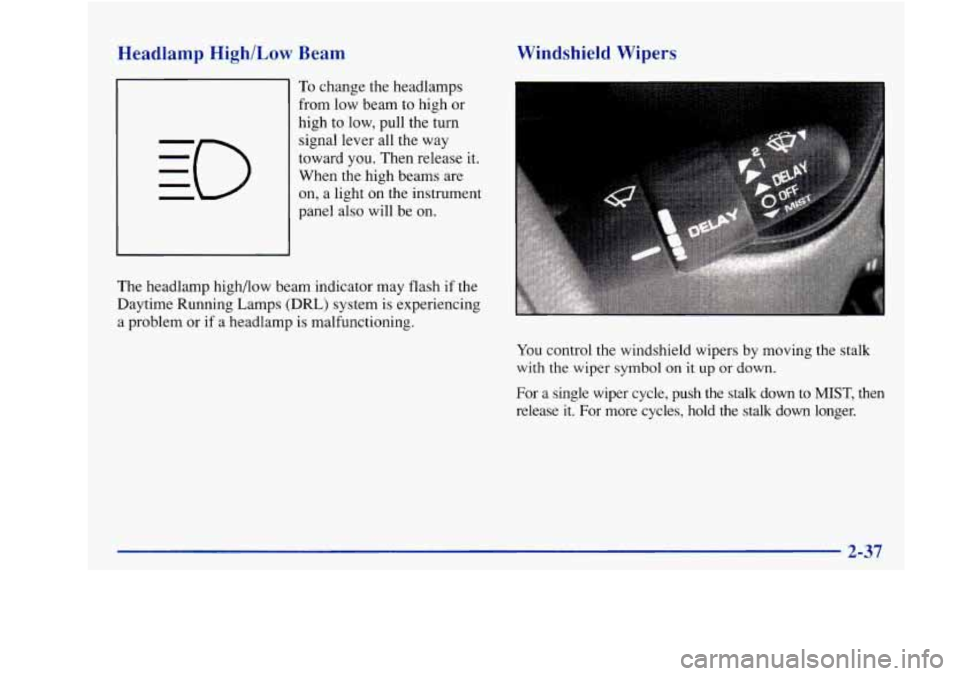
Headlamp High/Low Beam
To change the headlamps
from low beam to high or
high to low, pull the turn
signal lever all
the way
toward
you. Then release it.
When the high beams are
on, a light on the instrument
panel also will be on.
The headlamp high/low beam indicator may flash if the
Daytime Running Lamps (DRL) system is experiencing
a problem or if a headlamp is malfunctioning.
Windshield Wipers
'ti.
You control the windshield wipers by moving the stalk
with the
wiper symbol on it up or down.
For a single wiper cycle, push
the stalk down to MIST, then
release
it. For more cycles, hold the stalk down longer.
Page 94 of 372

For steady wiping at low speed, move the stalk up to
the
(1) position. For high-speed wiping, move the stalk
up further, to
(2). To stop the wipers, move the stalk
to OFF.
You can set the wiper speed for a long or short delay
between wipes. This can be very useful in light rain
or snow.
Move the stalk to
DELAY? then rotate the inner band and
choose the delay you want. Rotate the inner band
up for
shorter delay times between wiper cycles. Rotate the band
down for a longer delay time between wiper cycles.
Remember that damaged wiper blades may prevent
you
from seeing well enough to drive safely. To avoid
damage, be sure to clear ice and snow from the wiper
blades before using them.
If they’re frozen to the
windshield, carefully loosen or thaw them. If your
blades do become damaged, get new blades or
blade inserts.
Heavy snow or ice can overload your wiper motor.
A
circuit breaker will stop the motor until it cools. Clear
away snow
or ice to prevent an overload.
Windshield Washer
To wash your windshield, pull the stalk toward you until
the washers begin.
2-38
Page 95 of 372
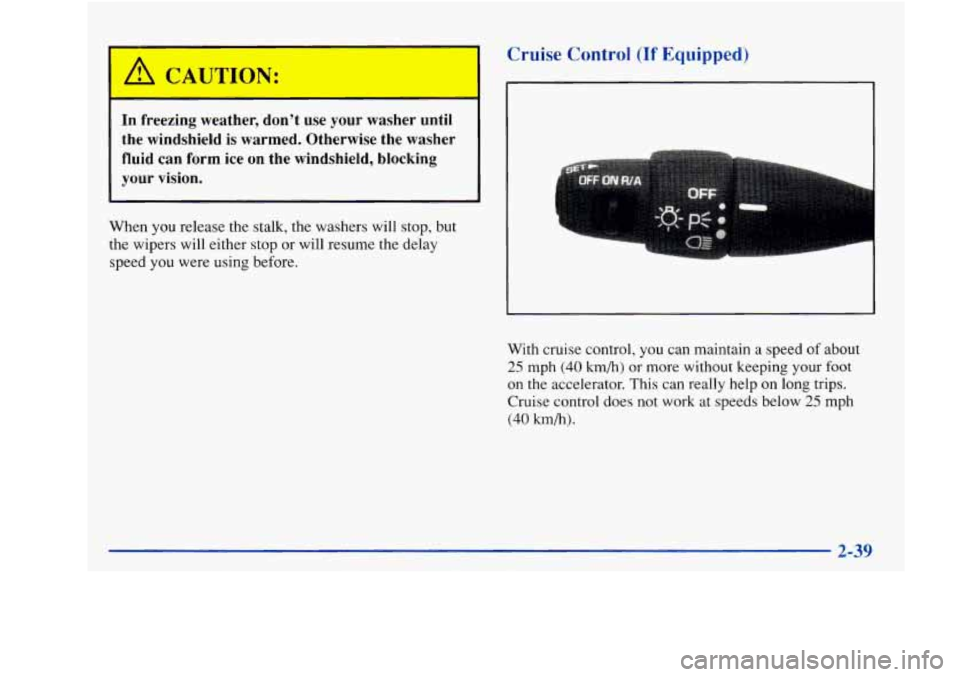
I I'ION: It
Cruise Control (If Equipped)
In freezing . :eather, don't use your washer until
the windshield is warmed. Otherwise the washer
fluid can form
ice on the windshield, blocking
your vision.
When you release the stalk, the washers will stop, but
the wipers will either stop or will resume the delay
speed
you were using before.
With cruise control,
you can maintain a speed of about
25 mph (40 km/h) or more without keeping your foot
on the accelerator. This can really help on long trips.
Cruise control does not work
at speeds below 25 mph
(40 km/h).
Page 96 of 372
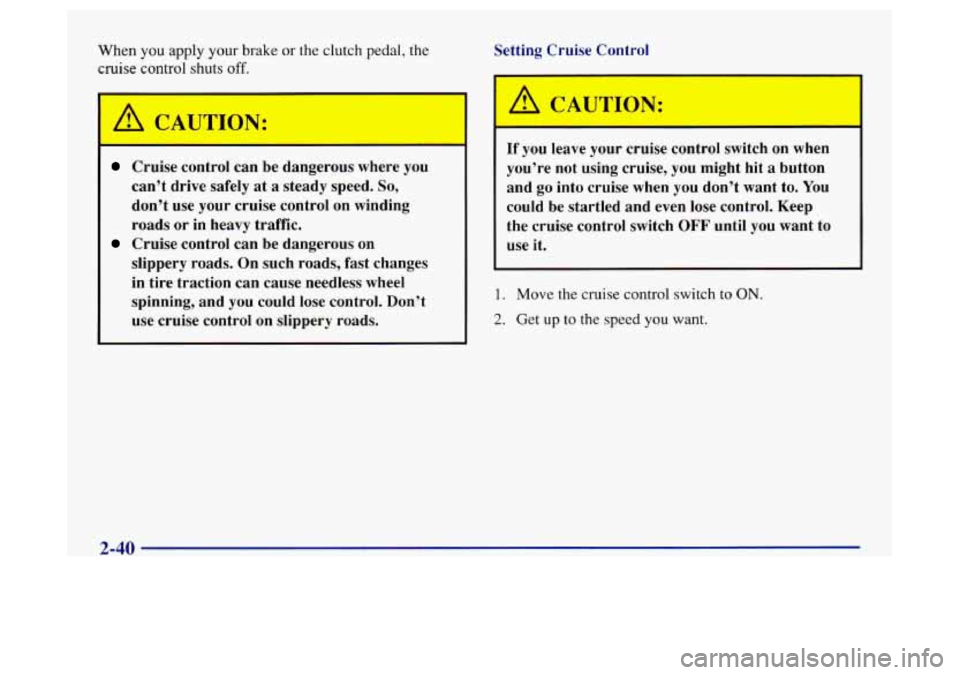
When you apply your brake or the clutch pedal, the
cruise control shuts off.
Cruise control can be dangerous where you
can’t drive safely at
a steady speed. So,
don’t use your cruise control on winding
roads or in heavy traffic.
slippery roads.
On such roads, fast changes
in tire traction can cause needless wheel
spinning, and
you could lose control. Don’t
use cruise control on slippery roads.
Cruise control can be dangerous on Setting Vruise Contra]
If you
leave your cruise control switch on when
you’re not using cruise, you might hit
a button
and go into cruise when you don’t want to. You
could be startled and even lose control. Keep
the cruise control switch
OFF until you want to
use
it.
1. Move the cruise control switch to ON.
2. Get up to the speed you want.
Page 97 of 372
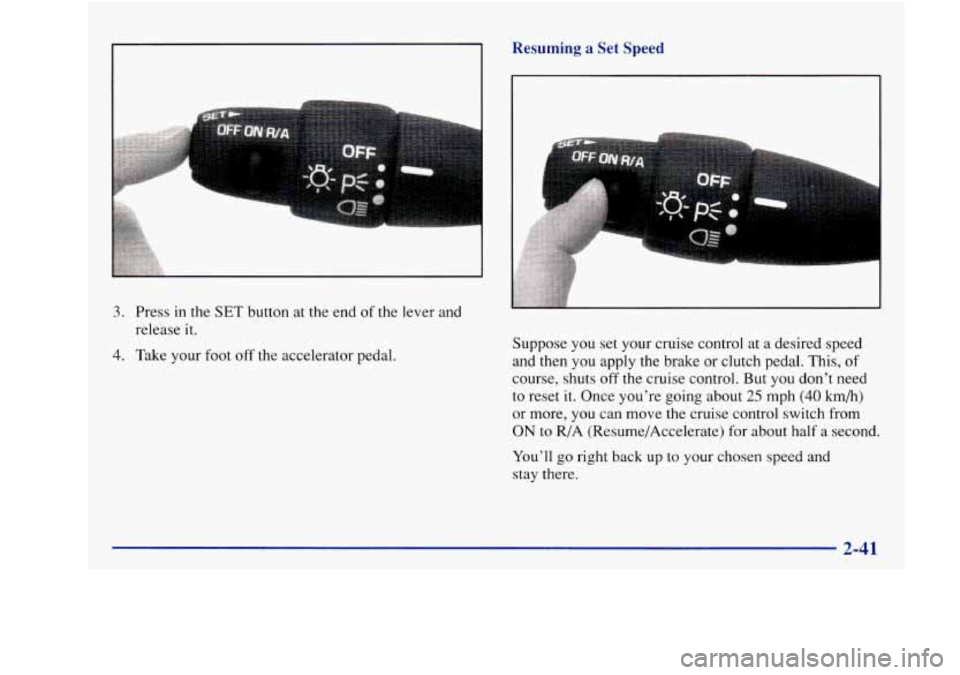
3. Press in the SET button at the end of the lever and
release it.
4. Take your foot off the accelerator pedal. Suppose
you set your cruise control at a desired speed
and then you apply the brake or clutch pedal. This, of
course, shuts off the cruise control. But you don’t need
to reset it. Once you’re going about
25 mph (40 km/h)
or more, you can move the cruise control switch from
ON to R/A (Resume/Accelerate) for about half a second.
You’ll
go right back up to your chosen speed and
stay there.
Page 98 of 372
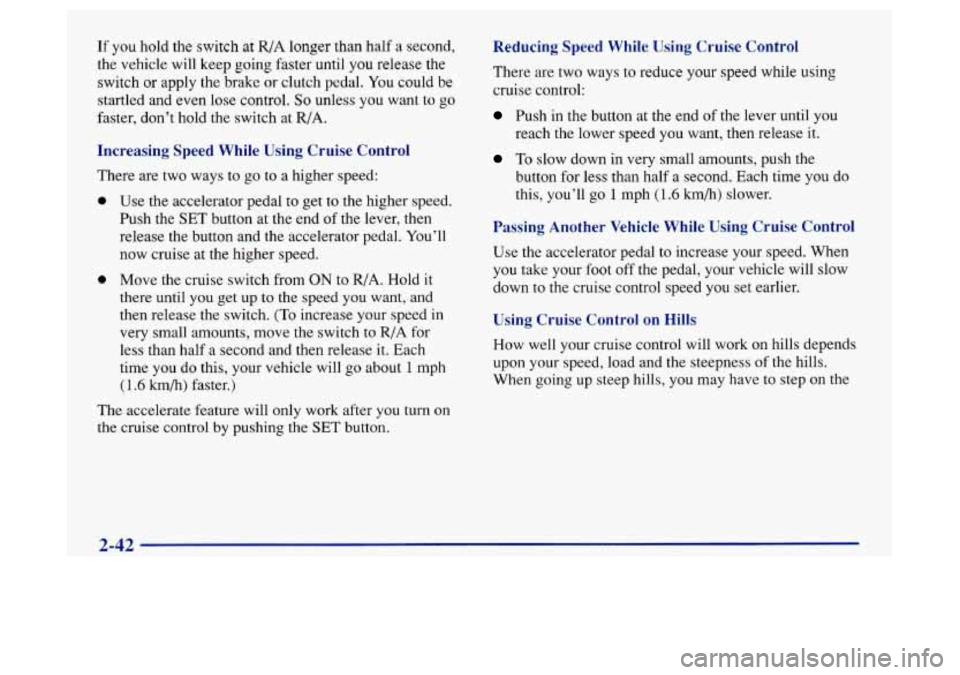
If you hold the switch at R/A longer than half a second,
the vehicle will keep going faster until
you release the
switch or apply the brake or clutch pedal.
You could be
startled and even
lose control. So unless you want to go
faster, don’t hold the switch at
R/A.
Increasing Speed While Using Cruise Control
There are two ways to go to a higher speed:
0
0
Use the accelerator pedal to get to the higher speed.
Push the SET button at the end of the lever, then
release the button and the accelerator pedal. You’ll
now cruise at the higher speed.
Move the cruise switch from
ON to R/A. Hold it
there until
you get up to the speed you want, and
then release the switch. (To increase your speed in
very small amounts, move the switch to
R/A for
less than half a second and then release
it. Each
time you
do this, your vehicle will go about 1 mph
(1.6 km/h) faster.)
The accelerate feature will only work after you turn
on
the cruise control by pushing the SET button.
Reducing Speed While Using Cruise Control
There are two ways to reduce your speed while using
cruise control:
Push in the button at the end of the lever until you
reach the lower speed you want, then release it.
To slow down in very small amounts, push the
button for less than half
a second. Each time you do
this, you’ll go
1 mph (1.6 km/h) slower.
Passing Another Vehicle While Using Cruise Control
Use the accelerator pedal to increase your speed. When
you take your foot off the pedal, your vehicle will slow
down to the cruise control speed you set earlier.
Using Cruise Control on Hills
How well your cruise control will work on hills depends
upon your speed, load and
the steepness of the hills.
When going up steep hills, you may have to step on the
2-42
Page 99 of 372
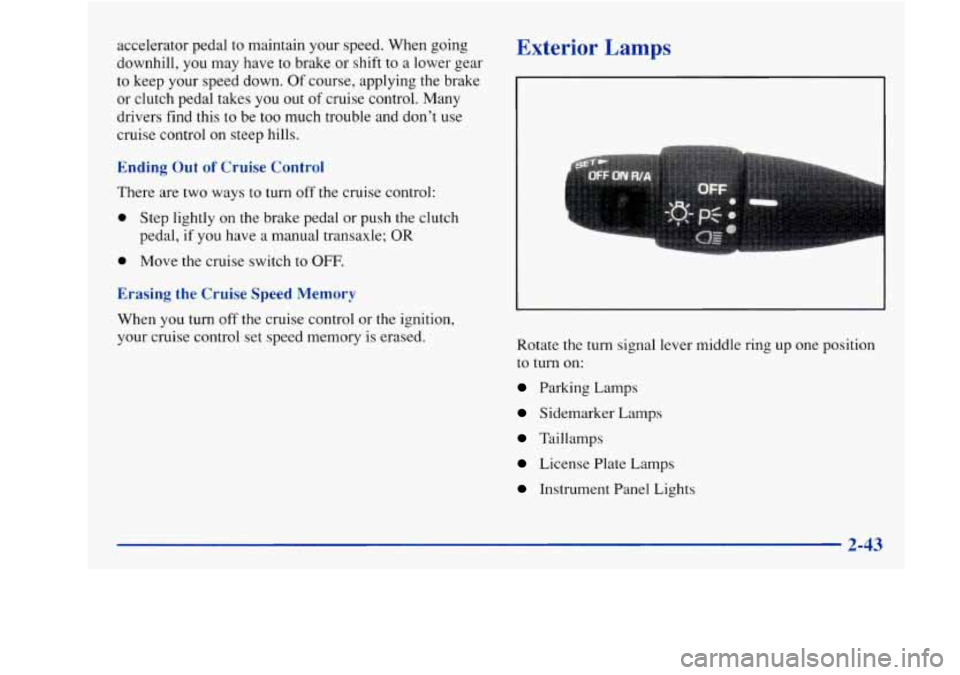
accelerator pedal to maintain your speed. When going
downhill, you may have to brake or shift
to a lower gear
to keep your speed down.
Of course, applying the brake
or clutch pedal takes you out of cruise control. Many
drivers find this to be too much trouble and don’t use
cruise control on steep hills.
Ending Out of Cruise Control
There are two ways to turn off the cruise control:
0 Step lightly on the brake pedal or push the clutch
pedal, if you have a manual transaxle; OR
0 Move the cruise switch to OFF.
Erasing the Cruise Speed Memory
When you turn off the cruise control or the ignition,
your cruise control set speed memory is erased.
Exterior Lamps
Rotate the turn signal lever middle ring up one position
to turn on:
Parking Lamps
Sidemarker Lamps
Taillamps
License Plate Lamps
Instrument Panel Lights
2-43
Page 100 of 372
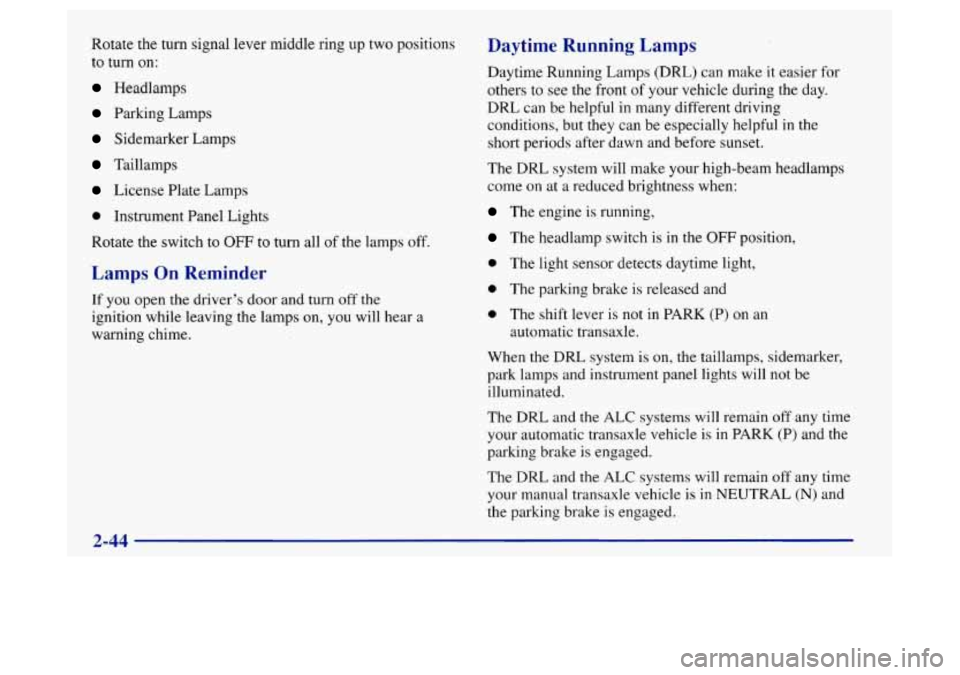
Rotate the turn signal lever middle ring up two positions
to turn on:
Headlamps
Parking Lamps
Sidemarker Lamps
Taillamps
License Plate Lamps
0 Instrument Panel Lights
Rotate the switch to
OFF to turn all of the lamps off.
Lamps On Reminder
If you open the driver’s door and turn off the
ignition while leaving the lamps on, you will hear a
warning chime.
Daytime Running Lamps
Daytime Running Lamps (DRL) can make it easier for
others to see the front
of your vehicle during the day.
DRL can be helpful in many different driving
conditions, but they can be especially helpful
in the
short periods after dawn and before sunset.
The DRL system will make your high-beam headlamps
come on at a reduced brightness when:
The engine is running,
The headlamp switch is in the OFF position,
0 The light sensor detects daytime light,
0 The parking brake is released and
0 The shift lever is not in PARK (P) on an
automatic transaxle.
When the DRL system is on, the taillamps, sidemarker,
park lamps and instrument panel lights will not be
illuminated.
The DRL and the ALC systems will remain off any time
your automatic transaxle vehicle is
in PARK (P) and the
parking brake
is engaged.
The DRL and the ALC systems will remain off any time
your manual transaxle vehicle is in NEUTRAL
(N) and
the parking brake is engaged.
2-44